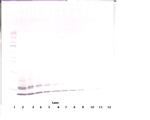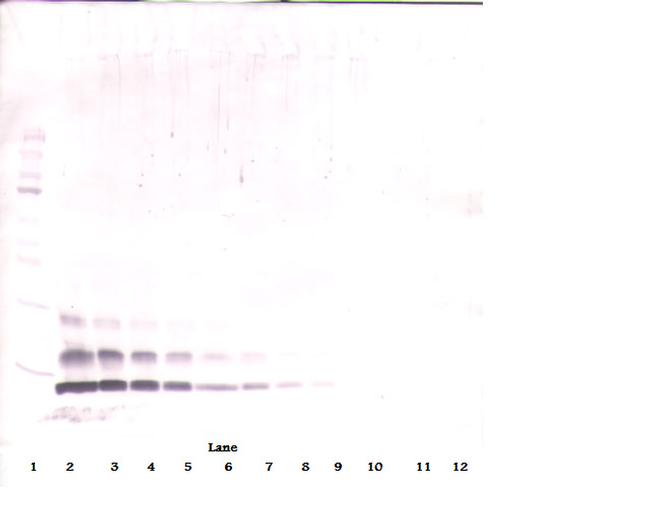Search Thermo Fisher Scientific
FIGURE: 1 / 3
CCL4 Antibody (500-P38BBT-25UG) in WB



Product Details
500-P38BBT-25UG
Species Reactivity
Host/Isotype
Class
Type
Immunogen
Conjugate
Form
Concentration
Purification
Storage buffer
Contains
Storage conditions
Shipping conditions
RRID
Product Specific Information
AA Sequence of recombinant protein: APMGSDPPTA CCFSYTARKL PHNFVVDYYE TSSLCSQPAV VFQTKRGKQV CADPSESWVQ EYVYDLELN.
Preparation: Produced from sera of rabbits immunized with highly pure Recombinant Human MIP-1beta (CCL4). Anti-Human MIP-1beta (CCL4)-specific antibody was purified by affinity chromatography and then biotinylated.
Sandwich ELISA: To detect Human MIP-1beta by sandwich ELISA (using 100 µL/well antibody solution) a concentration of 0.25-1.0 µg/mL of this antibody is required. This biotinylated polyclonal antibody, in conjunction with PeproTech Polyclonal Anti-Human MIP-1beta (500-P38B) as a capture antibody, allows the detection of at least 0.2-0.4 ng/well of Recombinant Human MIP-1beta.
Western Blot: To detect Human MIP-1beta by Western Blot analysis this antibody can be used at a concentration of 0.1-0.2 µg/mL. When used in conjunction with compatible secondary reagents, the detection limit for Recombinant Human MIP-1beta is 1.5-3.0 ng/lane, under either reducing or non-reducing conditions.
500-P38BBT-1MG will be provided as 2 x 500 µg
Target Information
CCL4 (macrophage inflammatory protein 1-beta, MIP1B) belongs to the intercrine beta (chemokine CC) family. Functionally, CCL4 is involved in chemotactic and proinflammatory effects, and homeostasis. CCL4 is produced by macrophages upon stimulation by bacterial endotoxins. CCL4 recruits and stimulates various inflammatory cells at sites of inflammation. CCL4 is produced by lymphocytes, macrophages and dendritic cells. Both CCL4 and the related protein CCL3 participate in the host response to invading bacterial, viral, parasite and fungal pathogens by regulating the trafficking and activation state of selected subgroups of inflammatory cells. While both CCL4 and CCL3 exert similar effects on monocytes, their effect on lymphocytes differ, with CCL4 selectively attracting CD4+ lymphocytes and CCL3 selectively attracting CD8+ lymphocytes. Additionally, both have been shown to be potent chemoattractants for B cells, eosinophils and dendritic cells. The processed form of CCL4 can induce down-modulation of surface expression of the chemokine receptor CCR5, thus inhibiting the CCR5-mediated entry of HIV-1 in T cells. CCL4 binds with high affinity to CCR5 receptors.
For Research Use Only. Not for use in diagnostic procedures. Not for resale without express authorization.
References (0)
Bioinformatics
Protein Aliases: ACT-2; C-C motif chemokine 4; chemokine (C-C motif) ligand 4; G-26 T-lymphocyte-secreted protein; HC21; LAG-1; Lymphocyte activation gene 1 protein; Macrophage inflammatory protein 1-beta; MGC104418; MGC126025; MGC126026; MIP-1-beta; MIP-1-beta(1-69); MIP1-beta; MIP1beta; PAT 744; Protein H400; RP23-320E6.8; secreted protein G-26; SIS-gamma; small inducible cytokine A4 (homologous to mouse Mip-1b); Small-inducible cytokine A4; T-cell activation protein 2
Gene Aliases: ACT2; AT744.1; CCL4; G-26; HC21; LAG-1; LAG1; MIP-1-beta; MIP1B; MIP1B1; SCYA2; SCYA4
UniProt ID: (Human) P13236
Entrez Gene ID: (Human) 6351

Performance Guarantee
If an Invitrogen™ antibody doesn't perform as described on our website or datasheet,we'll replace the product at no cost to you, or provide you with a credit for a future purchase.*
Learn more
We're here to help
Get expert recommendations for common problems or connect directly with an on staff expert for technical assistance related to applications, equipment and general product use.
Contact tech support
